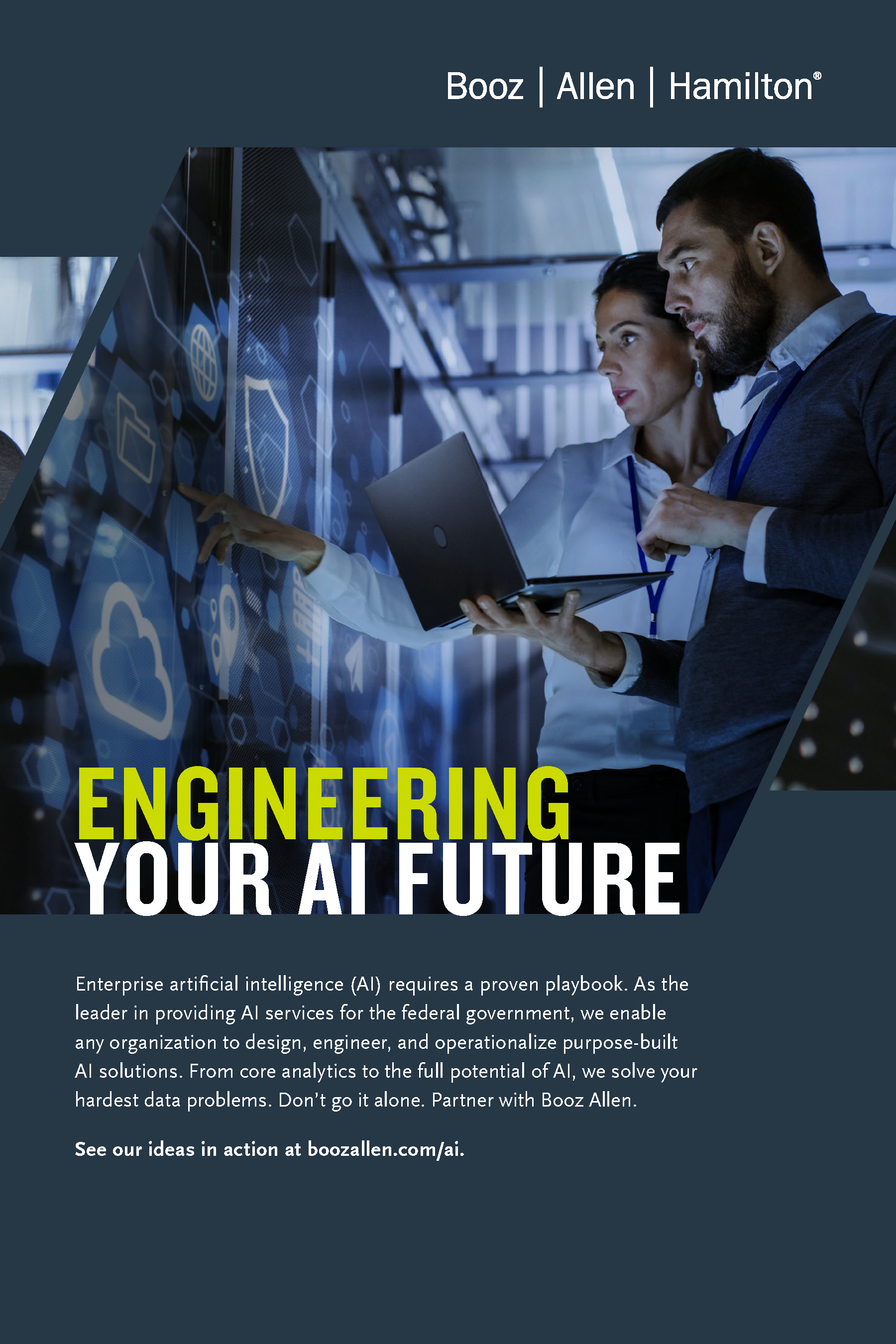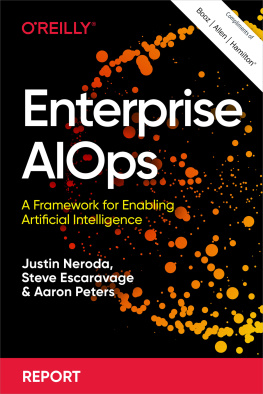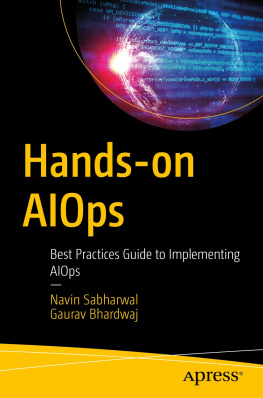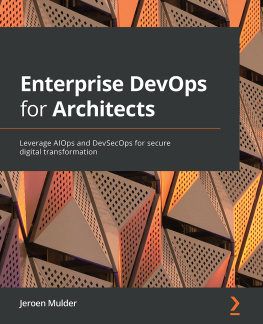Justin Neroda - Enterprise AIOps
Here you can read online Justin Neroda - Enterprise AIOps full text of the book (entire story) in english for free. Download pdf and epub, get meaning, cover and reviews about this ebook. year: 2021, publisher: OReilly Media, Inc., genre: Business. Description of the work, (preface) as well as reviews are available. Best literature library LitArk.com created for fans of good reading and offers a wide selection of genres:
Romance novel
Science fiction
Adventure
Detective
Science
History
Home and family
Prose
Art
Politics
Computer
Non-fiction
Religion
Business
Children
Humor
Choose a favorite category and find really read worthwhile books. Enjoy immersion in the world of imagination, feel the emotions of the characters or learn something new for yourself, make an fascinating discovery.
- Book:Enterprise AIOps
- Author:
- Publisher:OReilly Media, Inc.
- Genre:
- Year:2021
- Rating:3 / 5
- Favourites:Add to favourites
- Your mark:
- 60
- 1
- 2
- 3
- 4
- 5
Enterprise AIOps: summary, description and annotation
We offer to read an annotation, description, summary or preface (depends on what the author of the book "Enterprise AIOps" wrote himself). If you haven't found the necessary information about the book — write in the comments, we will try to find it.
Enterprise AIOps — read online for free the complete book (whole text) full work
Below is the text of the book, divided by pages. System saving the place of the last page read, allows you to conveniently read the book "Enterprise AIOps" online for free, without having to search again every time where you left off. Put a bookmark, and you can go to the page where you finished reading at any time.
Font size:
Interval:
Bookmark:


by Justin Neroda , Steve Escaravage , and Aaron Peters
Copyright 2021 OReilly Media Inc. All rights reserved.
Printed in the United States of America.
Published by OReilly Media, Inc. , 1005 Gravenstein Highway North, Sebastopol, CA 95472.
OReilly books may be purchased for educational, business, or sales promotional use. Online editions are also available for most titles (http://oreilly.com). For more information, contact our corporate/institutional sales department: 800-998-9938 or corporate@oreilly.com .
- Acquisitions Editor: Rebecca Novack
- Development Editor: Virginia Wilson
- Production Editor: Christopher Faucher
- Copyeditor: nSight, Inc.
Proofreader: Piper Editorial Consulting, LLC
- Interior Designer: David Futato
- Cover Designer: Randy Comer
- Illustrator: Kate Dullea
- August 2021: First Edition
- 2021-08-16: First Release
The OReilly logo is a registered trademark of OReilly Media, Inc. Enterprise AIOps, the cover image, and related trade dress are trademarks of OReilly Media, Inc.
The views expressed in this work are those of the authors, and do not represent the publishers views. While the publisher and the authors have used good faith efforts to ensure that the information and instructions contained in this work are accurate, the publisher and the authors disclaim all responsibility for errors or omissions, including without limitation responsibility for damages resulting from the use of or reliance on this work. Use of the information and instructions contained in this work is at your own risk. If any code samples or other technology this work contains or describes is subject to open source licenses or the intellectual property rights of others, it is your responsibility to ensure that your use thereof complies with such licenses and/or rights.
This work is part of a collaboration between OReilly and Booz Allen Hamilton. See our statement of editorial independence.
978-1-098-10726-0
[LSI]
A significant transformation is underway in the marketplace.
Mountains of data are being generated on a daily basis. Business operations, online transactions, vehicles and smart homes, our cell phone, and the increasing prevalence of the Internet of Things (IoT) means that data is continuously being generated and stored.
This growth in data vastly outstrips growth in the supply of technical analysts as demand for their services proliferates across industries. Companies, governments, and organizations are rightly asking how they can possibly provide value from these data volumes with their existing analytical capabilities and staff while determining where they need to invest to meet this growth.
When deployed effectively, Artificial Intelligence (AI) provides the necessary force multiplier, allowing organizations to generate insights not possible even a few years ago. AI provides organizations with the ability to process vast amounts of data by training algorithms to automate current processes, generate new insights, and then present these insights so that decision makers can act.
The ability for machines to solve problems and perform tasks that would normally require human capabilities and intelligence .
Rapid gains in computing power, inexpensive storage solutions for large volumes of data, and new research in algorithm development make AI increasingly more accessible. These three keysprocessing power, data, and algorithmsbring us to a new reality, one where AI can now meet or exceed human capability across a variety of diverse tasks.
Similar to past industrial revolutions, AIs adoption will have sweeping effects on our daily lives and work. Traditional business analytics (think Excel or basic statistical analyses) provided a historically competitive advantage to organizations in many industries. Now, companies are seeking the next wave of competitive advantage and strive for better performance in their analysesa result that effective AI deployments can deliver. As such, artificial intelligence will change how we conduct business, introducing new efficienciesand complexitiesthat we are just beginning to understand. Just as importantly, AI will fundamentally alter how you manage your teams, services, and operations.
The ability of strategic leaders to anticipate and guide these long-term changes will be essential to ensuring the success of this transition and allowing their organization to remain competitive. While there is growing consensus around AIs importance, there is a growing chasm regarding how to successfully deploy and apply artificial intelligence at an enterprise-wide scale. Many organizations are struggling with expanding, evolving, and integrating their early AI development efforts into mature, sustainable, enterprise-wide capabilities. This gap is due to the drastic increase in scope and complexity required to operationalize artificial intelligence, particularly in terms of integrating AI solutions within the larger organization.
This report is for business leaders who desire to transition AI from small, pilot projects to an enterprise-wide reality. We will introduce an artificial intelligence operations (AIOps) engineering framework to assist you in overcoming these post-pilot challenges through responsibly developing AI tools, the important role of data management , team roles and responsibilities, and large-scale implementation. The insights and strategies we share come from the lessons weve learned working at Booz Allen Hamilton on a portfolio of over 120 AI projects across the federal government.
By the end of the report, youll learn how to unlock the incredible potential that lies within your organizations exponentially growing data, deriving insights not available just a few years ago.
To extract the most benefit from this report, you should understand AIs fundamentals, its purpose, and what challenges can be solved when deploying AI-based solutions. If youd like a quick refresher or a deeper introduction to AI, our AI primer is a great place to start.
A huge thank-you to all the individuals who collaborated with us on this report. To the following colleagues: John Larson, Kathleen Featheringham, Elizabeth Cardosa, Alex Walter-Higgins, Caleb Wharton, Sheshadri Mudiyanur, Byron Gaskin, Jeffrey Gross, Chuck Audet, Drew Farris, Drew Leety, Geoff Schaefer, David McCleary, Susan Johnston, Katrina Jacobs, Catherine Quinn, and Catherine Ordunyour insight and contributions strengthened this piece considerably .
. You can view their 2021 report at their website, where they define AI on page 20.
, accessed July 13, 2021.
A majority of analytics exist to take operational data (e.g., past/present stock prices) and provide focused insights (e.g., predicted stock prices) that inform decision making. This essential objective is the same for conventional business analytics and AI analytics and includes a range of functions (e.g., automation, augmentation, conversational AI for consumers, etc.).
The key difference is how developers create the code that transforms operational data into insights. For conventional business analytics, this is a static process where the developer manually defines each logical operation the computer must take.
Font size:
Interval:
Bookmark:
Similar books «Enterprise AIOps»
Look at similar books to Enterprise AIOps. We have selected literature similar in name and meaning in the hope of providing readers with more options to find new, interesting, not yet read works.
Discussion, reviews of the book Enterprise AIOps and just readers' own opinions. Leave your comments, write what you think about the work, its meaning or the main characters. Specify what exactly you liked and what you didn't like, and why you think so.













